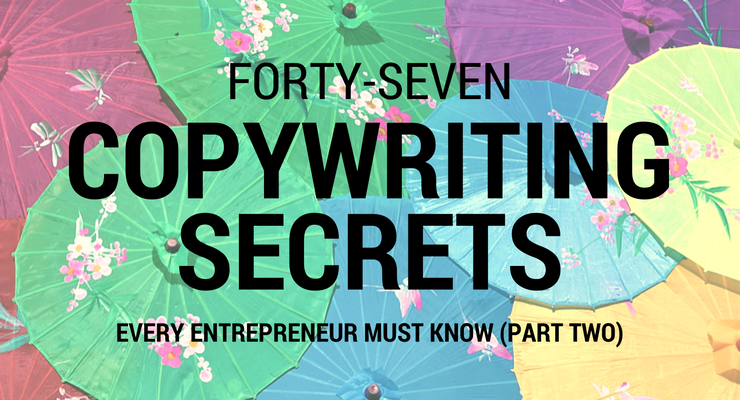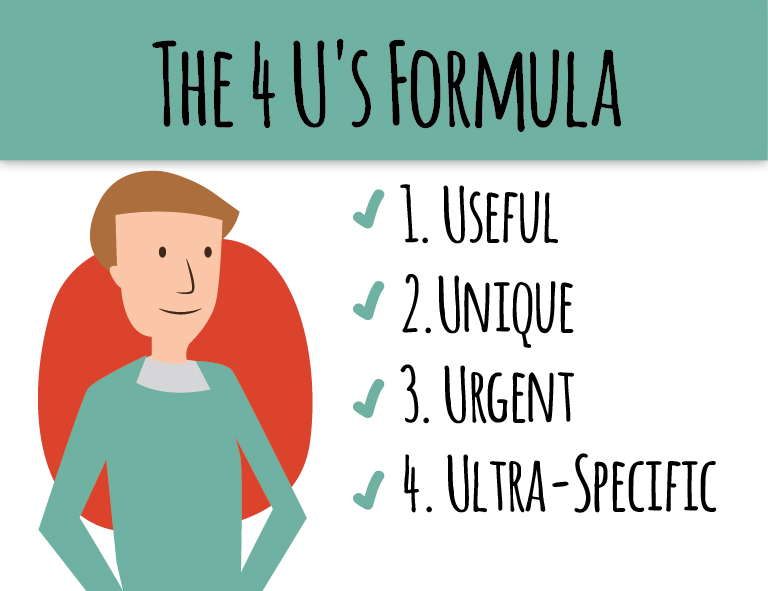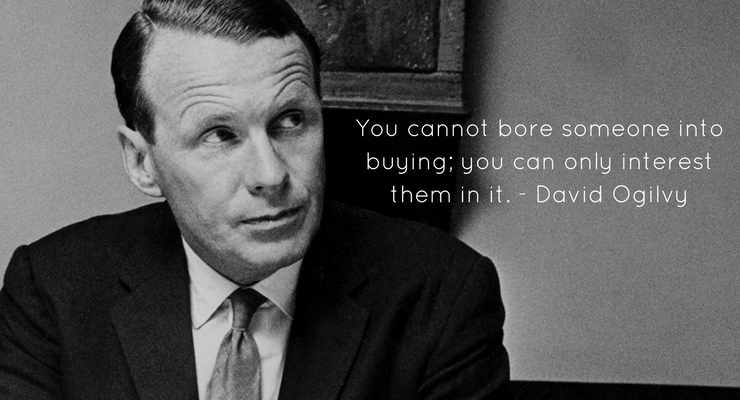
Welcome to Part Two of the 47 Copywriting Secrets Every Entrepreneur Must Know!
This 3-part article will help you transform your writing from limp and wimpy to POWERFULLY PERSUASIVE.
Because copywriting is just persuasion in print.
And when you can persuade in print EVERYTHING gets easier in your business:
Your blog attracts more readers, you hear “YES!” on more of your project proposals, your website makes more sales, you get to date supermodels and professional athletes — okay, the last one might be a stretch … but then again you never know!
The point is: copywriting — AKA persuasion in print — is one of the most profitable skills you can master as an entrepreneur.
And this 3-part article is fixin’ to show you how to do just that!
In Part One we looked at how to get inside your reader’s head to understand her wants, needs, hopes, and fears — and why that’s CRUCIAL to the success of your copy.
Here in Part Two you’ll discover:
- Why your headline is the single most important piece of copy you’ll write — and a proven 4-step formula that will have you whipping up winning headlines in no time!
- The “take this puppy home” trick that supercharges the persuasiveness of your copy …
- How to ignite your reader’s “lust of the mind” and turn him into a raving fiend for your writing … (WARNING: make a simple mistake with this technique and you’ll be as popular as a liberal at Trump rally with your audience!)
- What it means to let an old lady scream in your copy — and why doing so guarantees your readers will be hooked on whatever you have to say …
- And gobs more!
This post is all beef to the heels (that’s country-speak for “all meat, no filler) so let’s dig right in!
47 Copywriting Secrets
Every Entrepreneur Must Know
12. The Most Important Words You’ll Ever Write
You’ve taken the time to deeply connect with the needs, wants, desires, and fears of your prospect (we showed you how to do this in Part One).
Now it’s time to put pen to paper, fingertips to keyboard, and write your copy!
And no element of your copy is as important as your headline.
Your headline (which could be an email subject line, blog post title, or a traditional ad headline) is the first, and most critical, opportunity you have to seize your prospect’s attention.
On average, five times as many people read the headline as read the body copy.
Get it right, and you’ll pull your prospect word by word into your copy. Get it wrong, and your copy may as well not exist.
(Remember, for the purposes of our article “copy” stands for any piece of persuasive writing: not just ads but also blog posts, web pages, job proposals, etc.)
How important are headlines? I, myself, have re-headlined ads and increased their pull by 475%. Headlines are where I spend more creative effort than any other aspect of my work.” — Gary Halbert
So, yeah. Your headline is pretty important.
Important enough that we’re gonna take a deeper look at headlines before we move on to our other copywriting secrets.
13. Your Headline Must Accomplish Two Things
Your prospects are busy.
They have stacks of magazines, books, and a Netflix queue filled with material they’ve paid for that they don’t have the time to read or watch.
To paraphrase the great Claude Hopkins, they aren’t going to bother with your copy unless you make it worth their while and let the headline show it.
So, your headline must accomplish two things … and … it must accomplish them quickly.
Your headline must:
1. Capture the full attention of your ideal prospect, and …
2. Pull them into your copy, as if you were yanking them in by their eyeballs.
No prospect will read your ad, blog post, or email to find out if they’re interested in what you have to say — the headline MUST get them interested.
It’s job is to gain attention from qualified prospects … and … interest them enough to read the next word of your copy.
Think of it like this: Your headline should sell qualified prospects on the idea of reading your copy.
Then, you can let the body copy sell them on the idea of taking action.
We’ll explore the nuts and bolts of writing persuasive body copy in just a moment. But first …
14. The Anatomy Of A Damn Good Headline
Now that we know the job of any headline is to arrest the attention of a qualified prospect and pull them into your copy it’s time to look at the actual parts of an engaging headline.
A lot of world class copywriters have weighed in on what it takes to create powerful headlines.
One formula I find very helpful is The 4 U’s Formula popularized by business guru and master entrepreneur Michael Masterson.

Here’s a closer look at the 4 U’s with examples.
1. Useful: Does your headline deliver useful information to your prospect?
Example: “7 Home Improvement Secrets That Could Slash Your Utility Bills By Half!”
2. Unique: Does your headline deliver unique information?
Example: “Discover How a Hoboken, NJ Mother of Three Lost 27 Pounds in 4 Weeks … Eating Nothing but Caviar!”
3. Urgent: Does your headline light a fire under the prospect’s rear and make him want to read the sales copy RIGHT NOW?”
Example: “You Can Get 80% Off Your Next Oil Change … But Only if You Respond in the Next 24 Hours!”
4. Ultra-specific: Does your headline use specific details?
Example: “Join the 463 Chicago Area Residents Who’ve Already Claimed Their Free iPad”
Chances are your headline won’t nail all 4 U’s. And that’s okay. Very few headlines do.
But, if you can hit 2 or 3 you’ve got the makings of a potentially powerful headline on your hands.
And don’t limit yourself to just a single headline idea. You’re not going to hit the bullseye on your first try.
Go ahead and come up with dozens of ideas. You’ll really need to stretch yourself once you get past the 10 or 15 mark. But, in my experience, it’s those later ideas that hold the most potential.
15. Make Your Headline Answer These Two Questions
Once you’ve come up with 15, 20, or even 50 headline ideas (the more the better!) you’ll want to narrow it down to a handful of potential winners.
Now, take these two or three headlines and ask the following questions about them:
If I took my headline and ran it as a classified ad, and added a way to respond at the end of it … would people respond?” — Dan Kennedy
If I had unlimited, god-like powers and could grant my prospective customer the biggest benefit I can possibly imagine he or she would ideally want from my product, what would that benefit be … and does my headline show it?” — Ted Nichols
These two questions — posed by living marketing legends Dan Kennedy and Ted Nichols respectively — really force you to think about your headline in a prospect-specific, benefit-driven way.
Before a headline is ready to be tested with your market, revise it in the light of these two questions. I guarantee it will be stronger as a result.
16. Lead With Value
As you move from your headline and into the start of your body copy, give your reader something valuable.
This could be a useful tip, a juicy piece of gossip, a joke, or a weird fact — make it something that brightens your reader’s day.
If you’re giving away valuable content, people will be happy to hear from you … and they’ll be more likely to continue listening to what you have to say.
17. Push Your Reader’s Emotional Hot Buttons
Copywriting legend Matt Furey believes the key to greatness in writing is the quality of being emotionally free; willing and able to express yourself without resistance.
Don’t hold back when you craft your copy. Make your reader laugh, cry, or pound his fist on the desk. Push her emotional hot buttons.
Why? Because the things that impact our emotional states are the things that move us to action.
18. Tickle Your Reader’s 5 Senses To Engage Her Emotions
One of the best ways to get your reader emotionally invested in your copy is by stimulating her five senses with your writing.
Here are some examples …
Sight: “Do you see a bright future blooming with technicolor possibilities? Or are the weeks and months ahead dim, gray, and filled with uncertainty?”
Sound: “Haven’t you been silenced by your fears and insecurities long enough? It’s time for you to speak from your heart and tell the world how you really feel!”
Smell: “Is the rotten stench of corruption oozing out of Washington enough to make you gag?”
Touch: “Do you feel buried beneath the weight of your countless obligations? How would it feel to seize control of your life and race towards the future YOU desire?”
Taste: “Tired of choking down one failure after the next? Dig into sweet success with our brand new executive coaching program!”
19. How To Make Your Sentences Come Alive
The end goal of your copy is to get your prospect to do something: sign up for your email list, share your blog post, buy your offer — you want him to take ACTION!
Use active voice when you write to make your sentences come alive and prime your reader for action.
Here’s an example of active voice versus passive voice to show you what I mean:
- It was noted that hardly any of the population was satisfied with the president’s performance. (passive)
- A mob of furious people flooded the streets to shout and protest the president’s utter incompetence. (active)
In active voice something actively happens. You show an event rather than simply tell about it.
In other words …
20. Bring The Old Lady On Stage And Let Her Scream
When writing fiction it’s better to show than it is to tell.
Mark Twain once advised aspiring authors:
“Don’t say: ‘the old lady screamed’; bring her on and let her scream”.
You want to show more than you tell in your copywriting, too. Here are some examples of showing versus telling to get your gears turning:
- I have a red Lamborghini. (telling)
- I whipped my candy apple red Lamborghini into the hairpin turn at 90 mph and left the cop choking on my dust and cursing my name! (showing)
- Micah is a talented bass player. (telling)
- When Micah slaps and pops his bass guitar it sounds like his right hand is possessed by the spirit of a 70’s funk band. (showing)
Can you see how much more interesting and engaging the showing examples are?
21. Involvement And Ownership
If you’ve ever been in sales, then you know one of the most powerful tactics at your disposal is involving your prospect physically with your product.
This is why car dealerships are more than happy to let you take one of their vehicles out for a test drive.
It also explains why pet stores used to let you take a puppy home for the weekend to see how little Fido fit in at the house.
Both car dealerships and pet stores know that once you start physically engaging with their offer your sales resistance will begin to melt like snow on a warm spring morning.
In copywriting, you can’t usually get your prospect engaged physically with your product. But you can still take advantage of the power of involvement and ownership.
Here’s how:
Use words like “Imagine…” and “Picture yourself…” in your headline and body copy to get your prospect to feel like she’s already using your product.
When you increase your prospect’s sense of ownership you increase the likelihood of persuading her to take a specific action … no puppies necessary!
22. Ignite Your Reader’s “Lust Of The Mind”
Curiosity is arguably the strongest motivating factor at your disposal when you write copy.
The 16th-century British philosopher Thomas Hobbes put it best:

Fire up your reader’s lust of the mind by peppering your copy with expressions like:
- “But that’s only a small part of what makes this story so exciting …”
- “It gets even better …”
- What happened next really surprised me …”
You’ve seen this in the millions of ads floating around the Internet with headlines like:
“They thought this 90 year-old grandma died, but what happened next shocked everyone!”
Stoke your reader’s curiosity and you’re guaranteed to keep her reading. But fair warning: You MUST make sure there’s a payoff at the end.
A curiosity-inducing statement without an adequate reveal is just a “bait and switch” tactic — and a surefire way to tick off your readers. Don’t do that.
23. Tell Stories
We live for good stories.
If you can weave a compelling story through your copy, you’ll go a long way towards holding your reader’s interest — and compelling him to take action.
Selling is a matter of capturing people’s attention and holding it with a good story”. — Kathy Levine
You can create stories out of the history of your business/brand, user testimonials and case studies, as well as “slice of life” topics like movies, hobbies, and pop culture.
If you’d like to have a master-level copywriter walk you through how to use stories to create captivating copy, click here to listen to my interview with Jay White.
24. Use Simple, Clear Language
You don’t want your reader to come away from your copy thinking, “Wow, what a great piece of writing!”
You want him to read your copy and exclaim, “Wow! I need to take action right now!”
Remember that copy — be it an ad, blog post, web page, or email — is simply persuasion in print.
Simple, clear language is far more persuasive than long, flowery sentences and complicated words.
An easy way to check the clarity of your writing is with an online readability tool like Readability Score.
With this free tool you can check your Flesch-Kincaid Grade Level (FK), reading ease, and more.
For most persuasive writing, you should aim to keep your FK Grade Level below 8.
25. Pepper Your Copy With Benefit-Driven Bullet Points
Bullet points are a fine way to make your copy easier to read while stirring up oodles of benefit-driven interest at the same time.
Bullets, at their best, do NOT show features of what you’re selling. They show benefits of the features of your product or service.” — Scott Haines
Let’s look at some examples:
- Ex: This formula features 15 all-natural ingredients
- Better: Because our clinically-proven formula uses 15 all-natural ingredients, you’ll melt away 3 to 5 pounds of ugly fat per week … WITHOUT the need for calorie-counting diets and lung-shredding exercise.
You can also create “blind” bullet points to really stir up curiosity and interest:
- 90% of us have at least one GI parasite sapping energy and creating mood swings. Do you know the herb in your kitchen pantry that will cure you? Find out on page 17.
26. Being Boring Is The Kiss Of Death
Your copy must seize your reader’s interest like a pitbull snapping down on a pork chop or it will not be read.
Your reader absolutely will not trudge through boring copy that doesn’t speak to her interests.

Imagine yourself as your ideal reader and read your copy out loud. Do you feel excited as you read? Then chances are good your reader will feel the same.
But if you’re bored and disinterested you’ll want to go back through this list and look for ways to inject excitement and interest into your copy.
The #1 sin in marketing in general (and sales letters in particular) is being boring.” — Dan Kennedy
27. Activate The “Nod Factor”
As you work to capture and maintain your reader’s attention, you must also convince her the claims you make are true.
Start your ad with a statement that will be immediately and entirely accepted. And then build subsequent acceptances upon this first statement.” — Eugene Schwartz
You want to get your reader into the habit of nodding her heading and saying “Yes!” to the statements and claims made in your copy.
The easiest way to make a person believe what you are going to tell him is to first tell him something that he already knows is true.” Vic O. Schwab
You must seduce your reader’s heart if you want her to take action. But you have to reassure her brain — via proof and logic — that her emotional impulse is a good idea if you want her to follow through.
28. Use Specifics
One way to make your copy believable is through the use of specifics.
Platitudes and generalities roll off the human understanding like water from a duck. They leave no impression whatever.” — Claude Hopkins
Which do you find more convincing?
- This doodad is 80% more fuel-efficient than the leading brand, or…
- A 9-month trial at the Such-And-Such Technical Institute found that our doodad is 82.3% more fuel-efficient than the leading brand.
The second example, right?
If a section of your copy is vague or flabby, the solution is always more concrete details!” — Clayton Makepeace
Your reader is looking for reasons to believe or disprove what you’re telling him. Use specific details to convince him that what you’re saying is true.
29. The Power Of Testimonials
We’re social animals. And our tendency (whether we recognize it or not) is to look at the crowd to determine our own course of action.
In social psychology this tendency to follow the crowd is known as “social proof”. And one of the ways you see it deployed in sales and copywriting is through the use of testimonials.
What others say about you and your product, service, or business is at least 1,000 times more convincing than what you say.” — Dan Kennedy
Testimonials are one of the most powerful ways to convince readers and prospects that what you’re telling them is true — and therefore worth their time and attention.
Four guidelines to keep in mind for powerful testimonials:
- Be as specific as possible.
- Stick with ONE benefit per testimonial.
- Use the name and address of the person giving the testimonial.
- Keep the testimonial targeted to your audience.
And it should go without saying but let me quickly add: NEVER make up testimonials.
Not only is it lame but, in many cases, it’s also illegal.
Ready To Grab Your Reader
By The Eyeballs?
You now know how to grab your readers by the eyeballs with an attention-getting headline … and … how to hold her attention with benefit-driven, emotion-stirring body copy.
Look at you go, copywriting whiz kid!
In Part Three we’ll look at how to get your reader to take ACTION — be it sharing your post, replying to your project proposal, or purchasing your offer.
But first … I’ve got a challenge for you!
Take whatever piece of writing you’re working on right now — blog post, email, ad, whatever — and use the 4 U’s Formula you learned in this article to come up with 20 — 25 headlines.
Share your best headline in the comments section below if you’re feeling especially bold and saucy!
See you in Part Three, but before you go …
If you found these copywriting secrets helpful, would you please share this article by tapping or clicking the social share icons at the bottom of this page? Thank you!
Leave a Reply